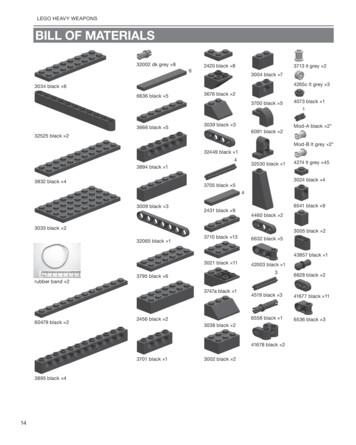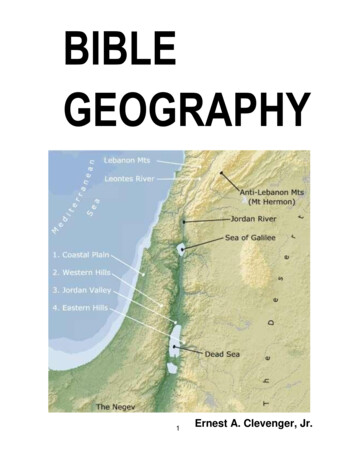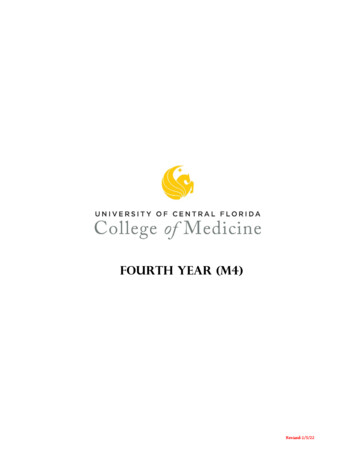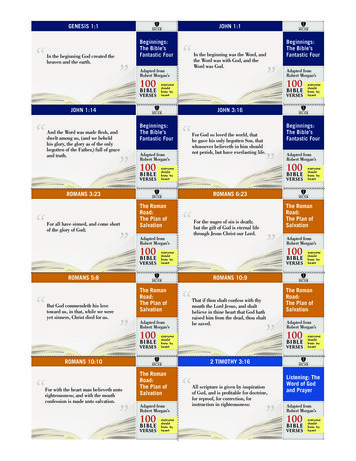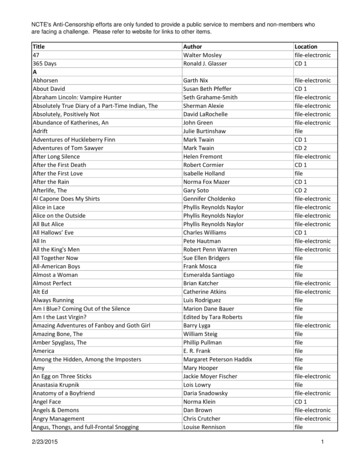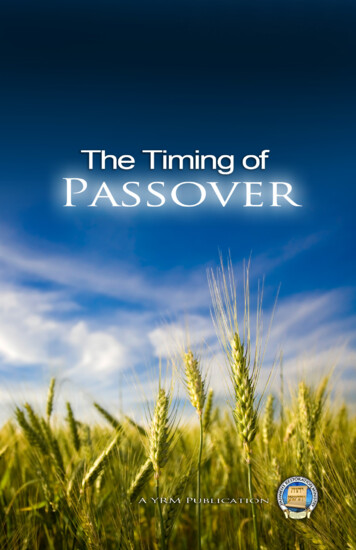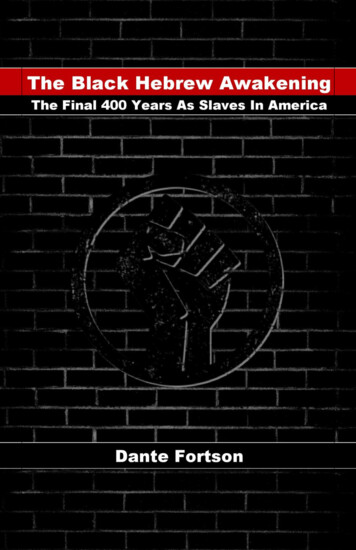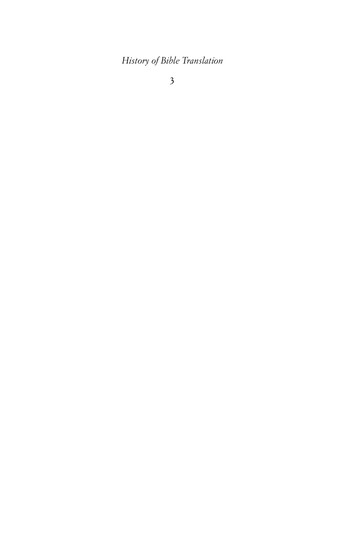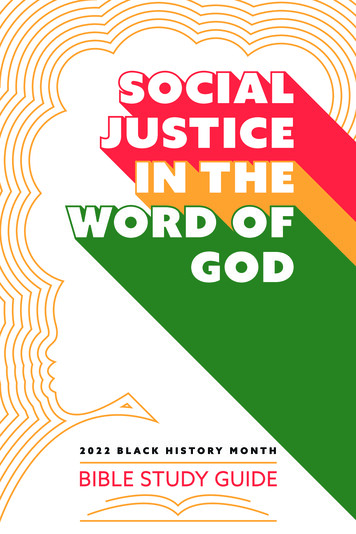
Transcription
2022 BLACK HISTORY MONTHBIBLE STUDY GUIDE
DEDICATIONThe Regional Caucus, comprised of the leadership of the nine regionalconferences and the coordinators and vice presidents for regional affairsof the North Pacific and Pacific Unions, is pleased to dedicate the BlackHistory Month Study Guide to the memory of:MRS. SHARON FORDHAMNovember 4, 1943 – July 18, 2021&ELDER HENRY FORDHAMAugust 27, 1943 – July 18, 2021Elder and Mrs. Fordham’s exemplary services in the cause of God, includingnine years of presidential leadership of the Allegheny East Conference, willforever remain a hallmark of elegance yoked with compassionate Christianstewardship.Did You Know historical facts courtesy of Benjamin Baker, Ph.D.For more information visit BlackSDAHistory.orgDesign & Layout: Liv JacobsonAdditional copies available from:AdventSource5120 Prescott AvenueLincoln, NE 68506AdventSource.org 2021 Office of Regional Conference MinistriesAll rights reserved. No part of this publication may be reproduced, stored in a retrieval system,or transmitted, in any form or by any means, electronic, mechanical, photocopying, recording,or otherwise, without the prior written permission of the copyright holder.Printed in the United States of AmericaISBN# 978-1-62909-983-5
S A B B AT H A F T E R N O O N – J A N U A RY 2 9DID YOU KNOW?1841William Still, famous black Abolitionist, became a Millerite1842William Foy, a Mulatto, was first to receive the “Gift of Prophecy”1843Sojourner Truth, famous matron of the Underground Railroad, accepted Adventist teachings1853Uriah Smith, (editor) wrote against Slavery in the Adventist paper, The Review and Herald1859Ellen White told Adventist members (contrary to the law) not to return” run-away slaves”1860The name Seventh-day Adventist was decided upon1861Ellen White saw in vision that America would pay for the “high crime of slavery”1862James White (editor) protested against slavery in Adventist paper, The Review and HeraldLESSON 1JANUARY 29–FEBRUARY 4Social Justice in The Old TestamentREAD FOR THIS WEEK’S STUDY:Exodus 20:1, 8–11; Leviticus 25; Deuteronomy5:12–15; 15:1–11; Psalm 14:4–6; 82:1–4; Proverbs19:17; 31:9; Isaiah 1:10–20; 10:1–2; 58:6–14;Amos 2:6–8; 5:11–15, 21–24; Micah 6:6–8.MEMORY TEXT:“He has showed you, O man, what is good. Andwhat does the LORD require of you? To act justlyand love mercy and walk humbly with your God.”MICAH 6:8 (NIV)In the Old Testament, the Hebrew word mishpat in many instances has a legal and judicial usage, andthus is translated “judgment.” However, in numerous occurrences, the context is not in reference tojustice in a judicial sense. Rather, the reference is to how people are treated in their social setting. Itoften stands parallel to tzedakah (the word for righteousness) precisely because tzedakah actuallymeans “justice” as in fair and equitable dealings in community. So, righteousness in the Old Testamentis not simply a private, personal quest or test for purity, but a divine imperative to live faithfully incommunity and deal justly with all beings.Throughout the Hebrew scriptures we find that God, on the one hand, is especially on the side of thosewho have been victimized, wronged, and mistreated. On the other hand, his judgment is harsh on theoppressors and the powerful. The first five books of the Bible, also known as the Torah or Pentateuch,are filled with laws and commands as to how Israel must treat the weak. These social-justice commandsmade sense when Israelites remembered their experience in Egypt. Social justice was born out of thatexperience—an experience of slavery, brutality, selfishness, and one-upmanship.This week we will focus on this social foundation of righteousness, particularly with reference to themost vulnerable, the exploited, the excluded, the marginalized, minoritized, the weakest in the societyand those who have few rights. In the Old Testament these included the poor, women (especiallywidows), orphans, immigrants/foreigners, eunuchs, etc.Lesson 11
S U N D AY : J A N U A R Y 3 0Sabbath And Social JusticeKey Text: “But the seventh day is the Sabbath of the Lord your God. In it you shall do no work: you, noryour son, nor your daughter, nor your male servant, nor your female servant, nor your cattle, nor yourstranger who is within your gates.” Exodus 20:10 (NKJV)Read Exodus 20:8–11; Deuteronomy 5:12–15. What specifically do you find in the weekly Sabbathcommandment that demonstrates social equity?In the Old Testament, the Sabbath commandment in all its forms lies at the foundation of socialjustice and the pursuit of righteousness. The Sabbath commandment legislates a leveling of the socialdistancing and differences between the employer/master, and the workers and subjected immigrants.The Deuteronomic recitation makes this more precise by the addition of, that they “may rest, as youdo.” All the powerless, including the animals of labor, are given the same rights as the powerful owner/master. See also Exodus 23:12.If God gave the Sabbath commandment today in your setting, which other contemporary underclasswould He include?Read Exodus 23:10–11; Leviticus 25:1–7; Deuteronomy 15:1–11. How do these Sabbath commandmentsspeak specifically to issues of the environment, economics, and the well-being of the most vulnerablein society?The weekly Sabbath levels the playing field and gives an “alternative to a life defined by production andconsumption of goods.” (Walter Bruggemann, Sabbath as Resistance, xiii–xiv). It’s a weekly pause fromthe unequal rat-race. The seventh-year Sabbath goes beyond this, and not only gives an ecologicaladvantage to the earth, but also gives the poor an opportunity to save and/or not to starve. And forthose burdened by the weight of debts (a major cause of poverty in the Old Testament), this is alegislative relief.Read Leviticus 25:8–24. How does this Year of Jubilee Sabbath prohibit multi-generational wealth andmulti-generational poverty?This may be the most revolutionary of the Sabbath commandments. It demands that all peoplehave the opportunity to succeed and not be dependent on the success or failure of previous familygenerations. These are legislative protections that ensure that the poor, helpless, and under-privilegeddo not remain in that state forever. It is interesting that Jesus, in the mode of the prophet Isaiah,describes his mission in terms of Jubilee, i.e., “the year of the Lord’s favor” (Isaiah 61:1, ff. Luke 4:18, ff).Read Acts 2:43–47; 4:32–35. The early Christian church established a system in which they could say,“there was not a needy person among them.”Read Isaiah 56:1–8. How does this passage speak to the issue of including the excluded?Seventh-day Adventist Sabbath-keepers should be the most inclusive community. Our communityshould be a welcoming one, no matter the social status of the “other.” We should not build fences toexclude the “other.”What can your church do to better achievethe Deuteronomy and Acts scenarios above?2Lesson 1
M O N D AY : J A N U A R Y 3 1Social Justice in Early IsraelKey Text: “You shall neither mistreat a stranger nor oppress him, for you were strangers in the land ofEgypt.” Exodus 22:21 (NKJV)Read Exodus 22:21–27; Deuteronomy 14:28–29; 24:10–22. Who were the most vulnerable in early,post-Egypt Israel?The narrative of the children of Israel traveling through the wilderness post-Exodus, portrays a peoplewho quickly forgot their experience of oppression and exploitation during their centuries of slavery.The social-justice laws, especially in Exodus, Leviticus, and Deuteronomy, including the Sabbathcommandments (just before they entered Canaan), were meant to emphasize the need to remembernot to forget how they were treated as marginalized people in Egypt. Social justice was born out ofthat experience – an experience of slavery, brutality, selfishness, and one-upmanship.The verses above specifically highlight the most vulnerable and marginalized: those reduced tohelplessness and poverty (widows and orphans in a patriarchal society being the weakest of the weak),and the underprivileged and/or second-class persons (foreigners/aliens/immigrants) among them.These immigrants and sojourners were the ethnic minorities traveling with the Israelites through thewilderness. These laws in the Torah specifically highlight this group because the children of Israel werean ethnic minority in Egypt and were oppressed and exploited as such.How would you contemporize these passages to the oppressed and exploited ethnic minority BlackIndigenous People of Color (BIPOC) in the Western Developed world?Read Exodus 22:21–27; 23:6–9; Leviticus 19:9–10, 33–36; 25:35–38; Deuteronomy. 24:6, 12–15, 17–18;25:13–16. What were some of the actions and social practices that kept people poor and marginalizedthat God had to legislate against?God did not leave it up to the individual to guess what actions and practices deprived the vulnerableof the good life. The laws in the Torah were specific: The use and misuse of pledges as collateral; debtsand interests; illegal weights; lack of opportunities to make a survivable living; misuse of the courtsystem in favor of the rich and powerful; etc.Nations like the USA often base their laws on the biblical principles and laws found in the ChristianScriptures. Would it also be appropriate for the secular government to enact social, economic, andenvironmental laws similar to those found in Exodus, Leviticus and Deuteronomy?Although there are threats of retribution, disaster, curses and even death on those who fail to treatthe vulnerable with justice, there are the promises of abundant blessings on those who are sociallyjust (Deuteronomy 15:10–11). Sadly, many Christians use Jesus’ citation of Deuteronomy 15:11 (“Thepoor you will always have with you”) as an excuse to not take care of the poor. What such believersfail to recognize, is that in the original Deuteronomy passage, God followed up by saying, “Therefore Icommand you to be openhanded toward your brothers and toward the poor and needy in your land.”Thus, because there will always be poor among us, we are commanded to generously care for them.Who in your opinion are the five mostvulnerable groups in society today?Lesson 13
T U E S D AY : F E B R U A R Y 1Social Justice in IsaiahKey Text: “Is this not the fast that I have chosen: To loose the bonds of wickedness, To undo the heavyburdens, To let the oppressed go free, And that you break every yoke?” Isaiah 58:6 (NKJV)The eighth century before the Christian era was a glorious time for both the southern kingdom ofJudah (with Jerusalem as its capital) and the northern kingdom (with Samaria as its capital). Therewas general peace between the divided kingdoms; their territorial boundaries had been expanded,their military was strong; and they boasted of the greatest economic growth and enjoyed significantprosperity. But the latter was only for the wealthy. The poor and marginalized suffered under theoppression and exploitation of the powerful.During this century God raised up four prophets: Isaiah and Micah in the south; and Amos and Hoseain the north. This is the only century recorded in scripture when God sent that many prophets withoracles of denouncement. These prophets spent much of their time denouncing idolatry. However,next at the level of intensity was their social-justice pronouncement.Read Isaiah 1:1–17 (esp. 10–17). Why would Isaiah begin his book with such a stern poem?In the midst of all the prosperity, religiosity, and well-being of the nation, Isaiah sees them not as thepeople of God, but as Sodom and Gomorrah—Sodomites who have a façade of true worship! ThatIsaiah begins his book with this oracle, is a strong indication of what he sees as most important.Worship, sacrifices, prayers, and all other liturgical practices (including worship on Sabbath) areinconsequential if they are not tied to justice for the weaker social groups in the society. In 1:16–17 Godand Isaiah not only call for ritual purification but for justice, especially for the weakest of the weak.Read Isaiah 1:18–20. In this context, what are the “sins” to which he refers? (cf. 1:21–25)For Isaiah the sins of social injustice are just as heinous in the sight of God as idolatry. We mustnote that reference to “fatherless and widows” is an example of the most vulnerable in an ancientpatriarchal society. For God’s people to sideline these most oppressed of the marginalized in thecommunity was an abomination. This parallels the words of James 1:27, “Religion that God our Fatheraccepts as pure and faultless is this: to look after orphans and widows in their distress and to keeponeself from being polluted by the world.” How often we focus on the personalized aspect of thisverse, and ignore the social dimension!Read Isaiah 58:1–8; 13–14. Note the social justice component of fasting rather than the traditionalritualistic practice. How do you think Isaiah intended his readers to tie-in Sabbath keeping with hissocial-justice oracle in vs. 6–7?In light of Sunday’s lesson, Isaiah may have had a broader, social-justice understanding of true Sabbathkeeping (that is more tied to Isaiah 58:6–7) than only the traditional interpretation that is usually given.In your own words, how is social justiceinvolved in Sabbath keeping?4Lesson 1
W E D N E S D AY : F E B R U A R Y 2Social Justice in The Minor ProphetsKey Text: “But let justice run down like water and righteousness like a mighty stream.” Amos 5:24(NKJV)The other three eighth-century Old Testament prophets mentioned in yesterday’s lesson were, whowe call Minor Prophets. We will use the oracles of Micah (south) and Amos (north) as illustrationsof spokesmen of God who attacked the national ideology of formal worship and religiosity, whilerejecting the fact that social justice for the marginalized was part and parcel of the essence of truereligion (cf. James 1:27 as noted in yesterday’s lesson).Micah, from the town of Moesheth, seemed to be one of the rural upper class. Amos was a wealthyshepherd (lit. “sheep breeder”), an owner of an estate who hires shepherds. It is significant that thesepowerful men (like Isaiah who was an aristocrat, who had access to high political circles, including theking), were the ones fighting for justice for the weak and vulnerable.Read Amos 2:6–8; 5:7–15, 21–24; 8:4–6; Micah 3:1–4, 8–12; 6:6–8. Note how these prophet-poets bringup the same issues that were clearly denounced in Exodus, Leviticus, and Deuteronomy. Note alsohow they parallel the messages of Isaiah in denouncing the formalized worship that was divorced fromjustice.These prophets were unrelenting in lashing out against the unjust practices that kept the marginalizedin a state of impoverishment, deprivation, and disadvantage. These oppressors and exploiters usedthe power of their status in society, and their connections to the religious and political power-brokersto take advantage of the disadvantaged. The prophets were unrelenting. They demanded justice forthe underclass. They were not interested in winning favors. They lashed out without fear or favor. Forexample, Amos not only lambasted the powerful merchant men; but called out their wives, referring tothem as over-fed fatted “cows of Bashan” who were complicit in the oppressive behavior (Amos 4:1–3).And Micah referred to the religious and political leaders as cannibals who distorted justice at so manylevels (Micah 3:1–4, 8–12).Can a Christian harbor racial animosity and perform acceptable worship? How would the eighthcentury prophets react to this contemporary practice?How far should members of the church go in being involved in social-justice issues? Is it okay todenounce publicly, political, civic, and religious leaders if they are enabling social injustice?In April 2021 the North American Division issued a statement, which said in part, “We fully supportthis conscientious witness of our members, especially our young adults, who advocate for andparticipate in the non-violent dismantling of such dehumanizing policies and practices that deny ourone humanity. Such advocacy fulfills the biblical calls of Micah 6:6–8 and Isaiah 58.”In what ways are you personally involved incombatting social injustice?Lesson 15
T H U R S D AY : F E B R U A R Y 3Social Justice in The PsalmsKey Text: “He will bring justice to the poor of the people; He will save the children of the needy, andbreak in pieces the oppressor.” Psalm 72:4 (NKJV)Read Psalm 9:12, 18; 10:14–18; 12:5; 14:6; 34:6; 35:10; 40:17; 82:1–4; 113:7–9. Note how God is adefender of the poor and afflicted. How would you respond to those who argue that these passagesare in reference to the spiritual poor and should not be interpreted socially or economically?Many students of scripture, in their attempts to minimize its social dimension, have spiritualizedthe poor and similarly afflicted persons in the Psalms This was especially prominent during theIntertestamental period (the centuries between the Old and New Testaments). This position continuesto pervade biblical interpretation by those who, due to political and social reasons, reject the biblicalteachings that God is on the side of the poor and oppressed. Here in these passages (as they were inthe passages in the previous lessons), we find the psalmist emphasizing that God will bring salvationto the afflicted and helpless. There will be a great reversal, a social inversion. God will lift up thehelpless and oppressed, and will bring down the wicked oppressors, calling them to account.Read Psalm 72:1–4, 12–14. How much does God expect the political leaders to be involved in issues ofsocial justice?Here, Solomon as a psalmist, specifically asked for God to endow him with justice to defend the poorand afflicted, and to crush the oppressor. Leaders need to see their responsibility as being defendersof the weak, the excluded, and those in distress, on the one hand; and prosecutors of the powerfulwho oppress the marginalized, on the other hand. Yes, God is the ultimate avenger. But he hasempowered leaders to call the oppressors of his people to justice.Read Psalm 94:1–10. Throughout the Old Testament we find time and time again God avenging hispeople, especially those who are oppressed and marginalized. At times he allows Israel to participate inacts of vengeance. Would it be appropriate for God’s people today to participate in acts of vengeanceagainst those who enable and participate in oppression?The New Testament addresses this directly. In Romans 12, the apostle Paul in addressing a numberof social ills, states clearly, “Do not take revenge, my friends, but leave room for God’s wrath, for it iswritten: ‘It is mine to avenge; I will repay,’ says the Lord” (v. 19). And in the epistle of James, chapter 5,the apostle rips into the rich and powerful for their oppression of the economic poor and oppressed.But like the practice of Jesus in the Gospels and Paul in Romans, he does not call on Christians toparticipate in acts of vengeance and violence against the evil oppressors. Instead, he calls for patience(5:7). However, James, Jesus, and the Psalmist envision a great inversion, a great reversal, when Godwill lift up the oppressed, and bring down the oppressor, and make them pay dearly for their sins.Explain why Jesus’ ministry effected achange from the Old Testament theology(system) of vengeance?6Lesson 1
F R I D AY : F E B R U A R Y 4Social Justice in ProverbsKey Text: “Open your mouth, judge righteously, and plead the cause of the poor and needy.”Proverbs 31:9 (NKJV)The book of Proverbs contains a collection of sayings that are practical. For the most part they areproverbs, not promises. They are true in their context. Thus, there are numerous proverbs that arepositive about wealth and the wealthy; but there are many that are negative. However, like the rest ofScripture, here in Proverbs, God is on the side of the poor. But it is clear that he hates poverty.Read Proverbs 11:1; 16:11; 19:5, 9, 28; 20:10, 23; 15:25; 22:22, 28; 23:10; 24:23–26. Note how the verythings that the Torah proscribes, the Proverbs has God detesting.Many persons tend to focus on a limited selection from Proverbs as to why people are poor: Suchthings as laziness, failure to plan, pursuit of pleasure over work, and just plain sinfulness. Unlike theProphets who almost singularly saw the cause of poverty as stemming from injustice and oppression,Proverbs, true to its nature, has an expanded list. To focus on one area and ignore the other, does notdo justice to the collection.There are numerous passages that speak of how the poor descended into poverty: being cheated byfalse weights, movement of landmarks, misuse of pledges, partiality of judges or by testimonies offalse witnesses. Proverbs 22:22–23 is especially firm in speaking against exploiting the poor because oftheir situation, and using the court system to oppress them. The passage warns that God will take uptheir case and destroy the oppressors.Reflect on the judicial and law enforcement system in 21st century America. Does race play a role inthe oppression of BIPOC persons?Read Proverbs 31:1–9. How do these proverbs speak to the attitude of rulers and the powerful? What isthe message of how to care for those who are oppressed and in distress?Here we have a very practical guide for both the strong leader and the suffering marginalized who arein distress. It speaks of the danger of addictive substances that will impair the ruler and cause him orher to make decisions that will deprive the oppressed of their rights. On the other hand, the one indistress needs medicinal care in order to survive their debilitating situation.In conclusion, Scripture is clear that God is on the side of the vulnerable, weak, and marginalized. Godis opposed to those who do not share this worldview. The ancient sage was correct in writing, “Hewho oppresses the poor [or any marginalized children of God] shows contempt for their Maker, butwhoever is kind to the needy honors God” (Proverbs 14:31, NIV).Discussion Questions:1. Since the civility of a society is judged by how it treats its mostvulnerable members, on a scale of 1–10, how would you rate thecountry where you live?2. How would you rate the religious organization to which you belong?3. How would you rate your personal involvement?Lesson 17
S A B B AT H A F T E R N O O N – F E B R U A RY 5DID YOU KNOW?1863John Byington, former active Abolitionist was elected first Seventh-day Adventist president1871Group of Colored “listeners,” first in the South, reported in Edgefield Junction, Tennessee1874Anna Knight, the first black S.D.A. woman missionary, was born in Jones County Mississippi1883First black S.D.A. church was organized in Edgefield Junction Tennessee1890Second black S.D.A. church was organized in Louisville, Kentucky1895Edson White opened the first church school for blacks aboard the boat, “The Morning Star”1896The General Conference commissioned purchase of Oakwood land (360 acres at cost of 8,000.00)1900Black S.D.A. membership was approximately 100LESSON 2FEBRUARY 5–11Social Justice in the Ministry of JesusREAD FOR THIS WEEK’S STUDY:Matthew 5:7; 19:16–21; Luke 18:1–8 (NIV);Luke 10:30–36MEMORY TEXT:“So in everything, do to others what youwould have them do to you, for this sums upthe law and the prophets”M AT T H E W 7 : 12 ( N I V )The concept of social justice has differing descriptions in the prophetic word as in Micah 6:8,Matthew 7:12 (the Golden Rule) and Luke 4:18–19, all of which speak to the same Divine principle.This is the principle of action enunciated by Jesus when He admonished His disciples (then andnow), that while expressing proper concern for the worshipful regulations of religion, to not neglect “themore important matters of the law [such as] justice and mercy.” Matthew 23:12–36.Nevertheless, many Christians, especially those who are theologically conservative, are suspicious of theterm, “social justice.” One reason for such fear is that the terms “social” and “justice” suggest to themnon-religious activities or secular projects outside of the gospel commission. This unfortunate view,shared by many Seventh-day Adventists, is best exposed by prayerful reflection on the compassionateministry of our Lord.Social Justice therefore, may be defined as the Divine mandate “to make right” one’s relationshipwith God, others and natural creation. In this light, its concerns assure equal opportunity for all,notwithstanding one’s religious affiliation, legal, political, economic status or other circumstances ofbirth and national origin. Join me as we explore the existence of these various qualities of social justice inthe ministry of Jesus.8Lesson 2
S U N D AY : F E B R U A R Y 6The Lowly Birth of JesusKey Text: “And she brought forth her firstborn Son, and wrapped him in swaddling clothes, and laid himin a manger, because there was no room for them in the inn.” Luke 2:7 (NKJV)In Genesis 3:15, we are given the very first promise of the Messiah. Why do you think God waited forfour thousand years to fulfill this pledge?Read Isaiah 11:1–10; Luke 2:1–7.In Isaiah 11:1–10, the prophet identified two totally different advents of the Messiah. In one prophecyHe’s called the shoot of a stump or a tender child and in another the Son of David, the powerful secondking of ancient Israel. (See Matthew 1:1; Luke 1 :32–33.)What did the prophet mean when he described the promised Messiah as “a shoot from the stump ofJesse”?Oxford dictionary defines stump as “the bottom part of a tree left projecting from the ground aftermost of the trunk has fallen or cut down. Isaiah indicated that the Messiah would come when thefamily of Jesse, including king David, who had been like a cedar in Israel, would be cut down and only a“stump” of Jesse, father of the ancient king David, would remain.Read Matthew 13:53–58. Discuss the ancient question: Can anything good come out of a ghetto? Arethere modern-day positive examples you can name?Witness in the four gospels the obscurity and poverty of Joseph and Mary, descendants of Jesse andthe royal house of David. Witness Joseph’s humiliation when Mary was about to give birth and hesought to claim his royal lineage as advantage to rent a room in an upscale inn and was turned away.Witness Mary, also a descendant of David, having no midwife to help deliver her firstborn to rub himwith salt according to their tradition, thus preventing the odors of afterbirth and infections. Witnessher placing Him in the trough used to hold food for the animals. Then, see her gently wrapping Him inswaddling clothes, the strips of linen left behind by shepherds who used them to protect newly bornlambs.Read Luke 4:18–19: Some Bible writers have applied these verses to the spiritual not the physicaldeliverance of those burdened by social handicaps and injustice. Are they correct?(See Isaiah 58:6–10, 61:1–2)Jesus was born into a society ruled by racism perpetrated by Rome. Because poverty rides the coattails of sin, He became sin for us so that we can be saved from its power and penalty. In doing so Heattended to the holistic needs of humanity. He valiantly labored to restore the physical as well as thespiritual dignity of those who were socially impoverished.If the birth of Jesus took place today, what cultural groups do youconsider God would favor with such a privilege and why?What is the difference between sympathy and empathy? What are theevidences in Jesus’ life that He had both? Why are both necessary forChristian service? How are they attained?Lesson 29
M O N D AY : F E B R U A R Y 7Jesus and the Status of WomenKey Text: “So God created man in His own image; in the image of God He created him; male and femaleHe created them.” Genesis 1:27 (NKJV)The equality of the genders seen at creation had, by Jesus’ time on earth, been disastrously distorted.Women were regarded as intellectually, morally, spiritually and physically inferior to men; as seen inscripture, they literally didn’t count.Read Genesis 1:26–27; Matthew 14:14–21; 15:33–38.From birth until marriage, usually at a very early age (12–14), women were under their father’sauthority and thereafter, under that of a husband, chosen by their father. They couldn’t hold or inheritproperty until God intervened (see Joshua 17:3–6). In effect, women were treated as chattel slaves,beings without moral or legal authority, unable to vote, own property, attain education and in manycases, leave their homes without permission. Jesus’ attitude and treatment was not just different, itwas revolutionary.Among the ways by which Jesus succeeded in enhancing womanhood are (fill in the blanks):1. Addressing females directly in public, something males in His day did not do.Examples are: John 4:7–18Luke 10:41–422. Addressing females as “Woman,” a polite term avoided by men.Examples are: John 2:4Luke 13:123. Addressing females as “Daughter” in publicExamples are: Matthew 9:22Mark 5:344. The vital use of females in His parables.Examples are: Matthew 13:33Luke 15:8–95. His miraculous female healings.Examples are: Mark 1:29–31Luke 8:43–446. His including women as part of His itinerant evangelistic team Luke 8:1–3Not to be overlooked is that while being purposely active in enhancing the status and roles of women,Jesus did not gloss over sin in their lives. Their sin was not condoned, but confronted. He thenprovided them forgiveness and the regenerating freedoms of repentance and obedience.Read 1 Peter 3:7. To what is Peter referring when he states that women are the weaker gender?What are some of the ways in which women suffer discrimination in their homes, in our denomination,in society in general?Are there ways in which men are weakerthan women?10Lesson 2
T U E S D AY : F E B R U A R Y 8Jesus and the Socially MarginalizedKey Text: “But when they saw it, they all complained, saying, He has gone to be a guest with a man whois a sinner.” Luke 19:7 (NKJV)Many first-century Jewish leaders considered those sociall
History Month Study Guide to the memory of: Elder and Mrs. Fordham's exemplary services in the cause of God, including nine years of presidential leadership of the Allegheny East Conference, will forever remain a hallmark of elegance yoked with compassionate Christian stewardship. MRS. SHARON FORDHAM November 4, 1943 - July 18, 2021 &
